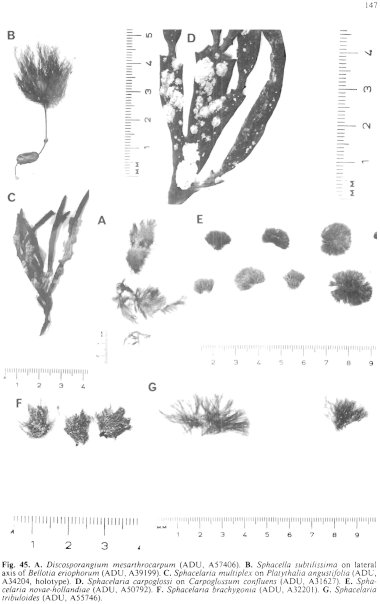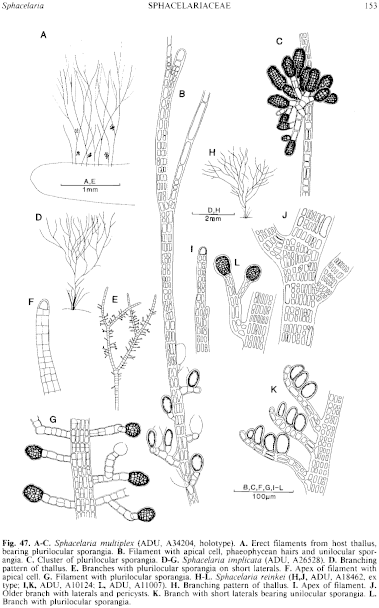|
|
|
|
|
|||||||||||
|
Electronic Flora of South Australia Species Fact Sheet
Phylum Phaeophyta – Order Sphacelariales – Family Sphacelariaceae
Thallus (Fig. 45C) medium brown, 2–5 mm long, forming dense masses on the host for 1–10 mm along the upper branches, with the numerous axes embedded just within the host meristoderm and arising singly, connected by slender rhizoids between the meristoderm cells. Branching (Fig. 47A) relatively sparse, irregular, with numerous long phaeophycean hairs (Fig. 47B) from upper and mid parts of branches, 10–12 µm in diameter; apical cells (Fig. 47B) relatively small. Axes 18–22 µm in diameter with segments L/B (0.5–) 0.7–1.2 (adjacent segments often variable in length), upper branches 14–18 µm in diameter with segments L/B (0.5–) 1–1.5 (–2); secondary transverse walls frequent (less so in plurilocular sporangial plants); pericysts present, moderately conspicuous.
Reproduction: Reproduction by ovoid unilocular sporangia (Fig. 47B) in small clusters of 1–5, each sporangium pedicellate, 30–40 Atm long and 20–28 µm in diameter and by ovoid to elongate-ovoid plurilocular sporangia (Fig. 47C) 30–50 µm long and 18–25 µm in diameter, borne in clusters of 5–20 from lower parts of axes (Fig. 47A).
Type from Sarge Bay, E. side of Cape Leeuwin, W. Aust., on Platythalia angustifolia, drift (Woelkerling, 16.xi.1968); holotype in ADU, A34204; isotypes distributed in "Marine Algae of southern Australia" No. 240).
Distribution: Only known from the type collection and Geographe Bay, W. Aust. (1879; MEL, 18802).
Taxonomic notes: S. multiplex is named from the clusters of numerous plurilocular sporangia borne on the lower branches. It is distinguished from other species with secondary transverse walls by its slender filaments (other species are over 35 µm in diameter), by the frequent, prominent and long hairs, as well as by the dense clusters of plurilocular sporangia.
References: The Marine Benthic Flora of Southern Australia Part II
Publication:
Womersley, H.B.S. (14 December, 1987)
The Marine Benthic Flora of Southern Australia
Part II
©Board of the Botanic Gardens and State Herbarium, Government of South Australia
Illustrations in Womersley Part II, 1997: FIGS 45C, 47 A–C.

Figure 45 enlarge
Fig. 45. A. Discosporangium mesarthrocarpum (ADU, A57406). B. Sphacella subtilissima on lateral axis of Bellotia eriophorum (ADU, A39199). C. Sphacelaria multiplex on Platythalia angustifolia (ADU, A34204, holotype). D. Sphacelaria carpoglossi on Carpoglossum confluens (ADU, A31627). E. Sphacelaria novae-hollandiae (ADU, A50792). F. Sphacelaria brachygonia (ADU, A32201). G. Sphacelaria tribuloides (ADU, A55746).

Figure 47 enlarge
Fig. 47. A–C. Sphacelaria multiplex (ADU, A34204, holotype). A. Erect filaments from host thallus, bearing plurilocular sporangia. B. Filament with apical cell, phaeophycean hairs and unilocular sporangia. C. Cluster of plurilocular sporangia. D–G. Sphacelaria implicata (ADU, A26528). D. Branching pattern of thallus. E. Branches with plurilocular sporangia on short laterals. F. Apex of filament with apical cell. G. Filament with plurilocular sporangia. H–L. Sphacelaria reinkei (H,J, ADU, A18462, ex type; I,K, ADU, A10124; L, ADU, A11007). H. Branching pattern of thallus. I. Apex of filament. J. Older branch with laterals and pericysts. K. Branch with short laterals bearing unilocular sporangia. L. Branch with plurilocular sporangia.

|
Email Contact: State Herbarium of South Australia |

|